Transform Your Garden with a Stone Flower Bed
Adding a stone flower bed is one of the best ways to give your garden structure, texture, and timeless beauty. Stone beds add a natural charm, drawing attention to the colors of the plants while providing a strong, durable boundary that can withstand all seasons. From planning and selecting materials to construction and maintenance, here’s everything you need to know to create a stunning stone flower bed that complements your landscape.
Choosing the Right Stones for Your Bed
Each stone type brings its own unique look to a flower bed. Here are some popular choices:
Flagstone: Great for creating a rugged, stacked appearance. Flagstone’s broad, flat shapes make it ideal for building tiered beds or retaining walls.
River Rock: Smooth and rounded, river rock offers a softer edge and works well as a decorative top layer in and around flower beds.
Limestone: With its light color and smooth finish, limestone is a classic choice, blending well with nearly any garden style.
Granite: Known for its toughness and vibrant color options, granite is ideal for bold designs. It’s resistant to weather, adding a lasting structure.
Slate: Slate’s rich, dark tones and layered texture create a refined, elegant look perfect for smaller beds and accent borders.

Step-By-Step Guide to Building a Stone Flower Bed
Step 1: Plan Your Design
Decide on the size, shape, and location of your flower bed. Think about the types of plants you’ll include and how much space they’ll need. Sketch a rough outline to visualize the layout.
Step 2: Select and Gather Materials
Choose your preferred stone type and make sure you have enough material to complete the project. For taller beds or walls, plan to have larger stones for the base to create stability.
Step 3: Prepare the Site
Clear any existing plants, weeds, and debris from the area. For a level surface, you may need to add a layer of gravel, especially if the ground is soft or uneven.
Step 4: Lay Your Stones
Begin by setting the base layer. Place the largest stones at the bottom and work upward. If stacking, stagger the stones in each row for a stronger structure. For curved edges, use smaller stones to create a smooth, rounded border.
Step 5: Fill with Soil and Plant
Add soil suitable for your chosen plants. Arrange your flowers and shrubs, making sure each one has room to grow. Once they’re in place, water them to help them settle.
Step 6: Finish with Mulch
Mulch provides a polished look, keeps soil moist, and discourages weeds. A layer of mulch between plants helps unify the bed and enhances the contrast with the stone border.

Inspiring Stone Flower Bed Designs
Curved Flower Beds
Curved edges soften a garden’s appearance and bring a gentle flow, ideal for edging along pathways or lawns.
Raised Stone Beds
Ideal for small spaces, raised beds are easy to maintain and offer excellent drainage, making them perfect for vegetables or plants needing drier soil.
Tiered Beds for Sloped Landscapes
Tiered beds create a dramatic look on slopes, allowing you to layer plants of different heights and textures.
Central Circular Beds: Stone circles make beautiful centerpieces for larger gardens. They work especially well with stones of varied sizes, adding height and a focal point.
Tips for Maintaining Your Stone Flower Bed
Check for Shifting: Extreme weather can shift stones over time, so periodically check to keep everything in place.
Keep Stones Clean: Regularly clean the stones to prevent moss and dirt from accumulating. A quick rinse will usually do the trick.
Reapply Mulch Annually: Mulch breaks down and fades with time. A fresh layer each year not only refreshes the look but also benefits your plants.
A well-built stone flower bed is a lasting addition that brings character and depth to your garden. Whether you go for a curved border or a raised circular centerpiece, stone beds add a timeless beauty that highlights your plants and provides structure to your landscape. Ready to get started? With the right materials and a bit of effort, you’ll soon have a stone flower bed that will thrive for years to come.



